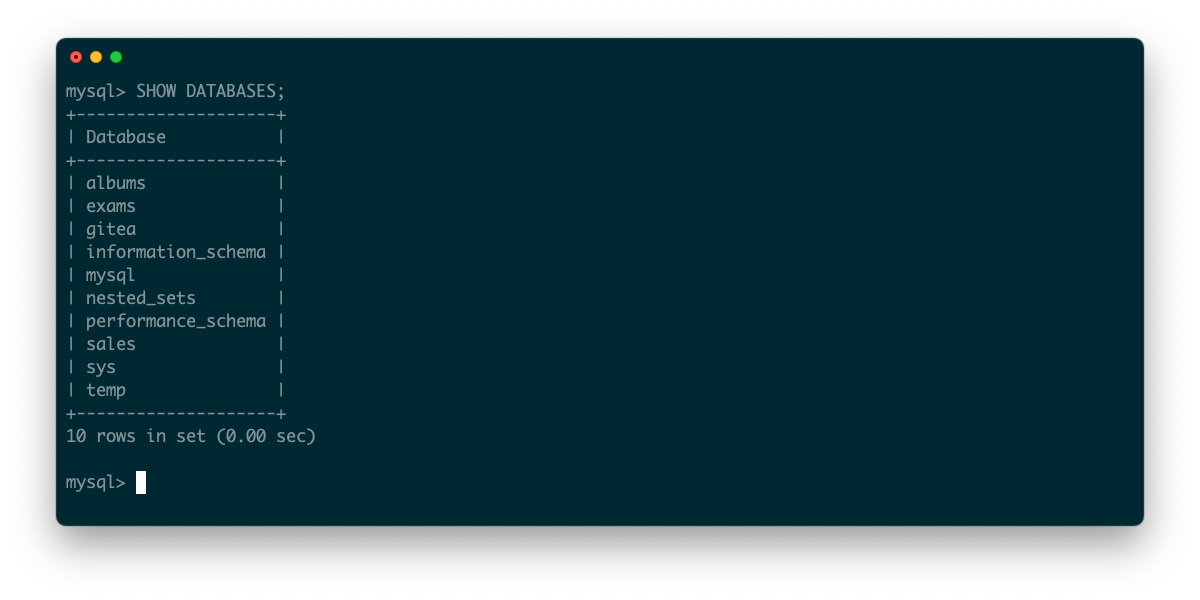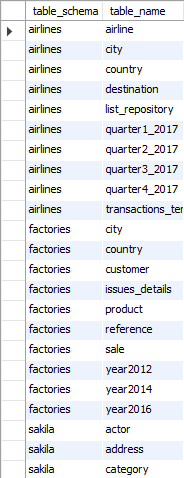

- MYSQL LIST DATABASES WITH COLALTION UPDATE
- MYSQL LIST DATABASES WITH COLALTION FULL
- MYSQL LIST DATABASES WITH COLALTION PASSWORD
MODIFY VARCHAR(140) CHARACTER SET utf8mb4 The safest way is to modify the columns first to a binary type and then modify it back to it type using the desired charset.Įach column type have its respective binary type, as follows:Įg.: ALTER TABLE.
MYSQL LIST DATABASES WITH COLALTION UPDATE
In PHPMailer, just update this line: public $CharSet = 'utf-8' If you are sending emails using utf8 data, you might want to also convert your emails to send in UTF8. I had a situation where certain characters "broke" in emails even though they were stored as UTF-8 in the database. Éleanore and Eleanore might be considered the same in some collations.

Make sure to choose the right collation, or you might get unique key conflicts. Here is an example: ALTER TABLE t1 CHANGE c1 c1 BLOB ĪLTER TABLE t1 CHANGE c1 c1 VARCHAR(100) CHARACTER SET utf8 Then to a nonbinary column with the desired character set. Set, you can convert the column to use a binary data type first, and If the contents are encoded in a different character If the column has a nonbinary data type (CHAR, VARCHAR, TEXT), itsĬontents should be encoded in the column character set, not some otherĬharacter set. In case the data is not in the same character set you might consider this snippet from (like following) ALTER TABLE rma CHARACTER SET utf8 COLLATE utf8_general_ci ALTER TABLE rma CONVERT TO CHARACTER SET utf8 COLLATE utf8_general_ci ĪLTER TABLE rma_history CHARACTER SET utf8 COLLATE utf8_general_ci ALTER TABLE rma_history CONVERT TO CHARACTER SET utf8 COLLATE utf8_general_ci ĪLTER TABLE rma_products CHARACTER SET utf8 COLLATE utf8_general_ci ALTER TABLE rma_products CONVERT TO CHARACTER SET utf8 COLLATE utf8_general_ci ĪLTER TABLE rma_report_period CHARACTER SET utf8 COLLATE utf8_general_ci ALTER TABLE rma_report_period CONVERT TO CHARACTER SET utf8 COLLATE utf8_general_ci ĪLTER TABLE rma_reservation CHARACTER SET utf8 COLLATE utf8_general_ci ALTER TABLE rma_reservation CONVERT TO CHARACTER SET utf8 COLLATE utf8_general_ci ĪLTER TABLE rma_supplier_return CHARACTER SET utf8 COLLATE utf8_general_ci ALTER TABLE rma_supplier_return CONVERT TO CHARACTER SET utf8 COLLATE utf8_general_ci ĪLTER TABLE rma_supplier_return_history CHARACTER SET utf8 COLLATE utf8_general_ci ALTER TABLE rma_supplier_return_history CONVERT TO CHARACTER SET utf8 COLLATE utf8_general_ci ĪLTER TABLE rma_supplier_return_product CHARACTER SET utf8 COLLATE utf8_general_ci ALTER TABLE rma_supplier_return_product CONVERT TO CHARACTER SET utf8 COLLATE utf8_general_ci WHERE C.collation_name = T.table_collationĪND T.table_schema = 'your_database_name'Īdjusting table columns' collation and character setĬapture upper sql output and run it. 'ALTER TABLE ', table_name, ' CONVERT TO CHARACTER SET utf8 COLLATE utf8_general_ci ')įROM information_schema.TABLES AS T, information_schema.`COLLATION_CHARACTER_SET_APPLICABILITY` AS C 'ALTER TABLE ', table_name, ' CHARACTER SET utf8 COLLATE utf8_general_ci ', Identifying Database Tables with the incorrect character set or collation SELECT CONCAT( Identifying the Collation and Character set of your database SELECT DEFAULT_CHARACTER_SET_NAME, DEFAULT_COLLATION_NAME FROMĭEFAULT_COLLATION_NAME not like 'utf8%') įixing the collation for the database ALTER DATABASE databasename CHARACTER SET utf8 COLLATE utf8_unicode_ci

MYSQL LIST DATABASES WITH COLALTION FULL
The WHERE clause provides more flexibility to list the database that matches the given condition in the SQL statement.Before proceeding, ensure that you: Have completed a full database backup! The LIKE clause list the database name that matches the specified pattern. Show Databases command in MySQL also provides an option that allows us to filter the returned database using different pattern matching with LIKE and WHERE clause. We can understand it with the following output: List Databases Using Pattern Matching This command is the synonyms of the SHOW DATABASES and gives the same result. MySQL also allows us another command to list the databases, which is a SHOW SCHEMAS statement. We can see the following output that explains it more clearly: Finally, run the SHOW Databases command to list/show databases. Now, you are connected to the MySQL server host, where you can execute all the SQL statements.
MYSQL LIST DATABASES WITH COLALTION PASSWORD
Next, log in to the MySQL database server using the password that you have created during the installation of MySQL. Open the MySQL Command Line Client that appeared with a mysql> prompt.


 0 kommentar(er)
0 kommentar(er)
